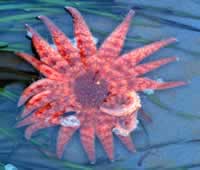You are here: Home › Ecosystems › Estuarine Ecosystems
Estuarine Ecosystems
 Estuaries are semi–enclosed bodies of water where freshwater and ocean tides connect such as rivers, lakes, and shorelines. Estuaries currently account for approximately 4,541,666 acres of U.S. coastlines, and provide food, breeding grounds, and habitats to a variety of endangered plants and species.
Estuaries are semi–enclosed bodies of water where freshwater and ocean tides connect such as rivers, lakes, and shorelines. Estuaries currently account for approximately 4,541,666 acres of U.S. coastlines, and provide food, breeding grounds, and habitats to a variety of endangered plants and species.
Unlike other coastal systems in terms of nutrients, water levels, and temperatures, estuaries are among the most productive environments supporting commercial fisheries around the world and vital to the economy.
An important goal of NCCOS research is to identify the link between human activities and the increasing number of ecological disturbances observed within estuarine environments. Factors such as climate change, pollution, and coastal damage often decrease freshwater flow producing contaminants, which lead to negative impacts on human health.
NCCOS works to understand the dynamic relationship between humans and coastal habitats though remote sensing and physical observation providing coastal managers the tools needed to protect public health, restore damaged habitats, and improve community interactions with surrounding ecosystems.
To look up NCCOS projects affecting Estuaries, use the NCCOS Project Explorer (opens in a new window).
The National Estuarine Research Reserve System
The National Estuarine Research Reserve System is a network of 26 protected areas established for long–term research, education, and stewardship. This partnership program between NOAA and coastal states protects more than one million acres of estuarine land and water; offers educational opportunities for students, teachers and the public; and serves as "living laboratories" for scientists. Established by the Coastal Zone Management Act of 1972, as amended, the National Estuarine Research Reserve System serves as reference sites for research, education and stewardship. Reserves represent different biogeographic regions of the U.S.
A biogeographic region is a geographic area with similar dominate plants, animals and prevailing climate. There are 11 major biogeographic regions around the coast, with 29 sub regions. The reserve system currently represents 18 of those sub regions. The reserve system is designed to include sites representing all 29 biogeographic subregions, with additional sites representing different types of estuaries.
The National Estuarine Research Reserves serve as living laboratories for on–site staff, visiting scientists, and graduate students. Since its inception, a main goal of the program has been to ensure a stable environment for research through long–term protection of reserve system resources. The reserves serve as platforms for long–term research and monitoring, education, as well as reference sites for comparative studies.
NOAA»s mandate is to ensure a stable environment for long–term research, education, and interpretation through protection of reserve system resources.
To look up NCCOS Projects involving NERRS, use the NCCOS Project Explorer (opens in a new window).
Resources
Related Topics
- Kachemak Bay Reserve / Mt. Augustine update
- Estuary Restoration Monitoring Introduction and PDF Download area
- Monitoring Coastal Restoration Projects factsheet
- CSCOR Estuaries page
- CCMA Estuaries page
- CCFHR Estuaries page
- CCEHBR Estuaries page
- HML Estuaries page
- NOAA’s Chesapeake Bay Office
- National Coastal Conditions Report (on EPA’s web site – will open in an new window)



